How to write Amazon titles and product descriptions that convert – with real examples
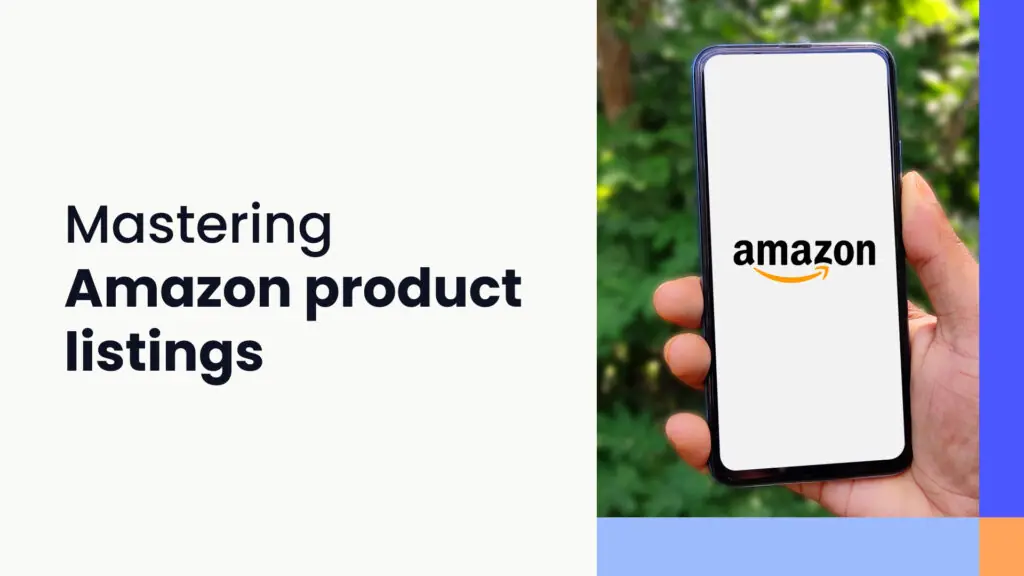
- What are Amazon product listings and why do they matter?
- Why focus on Amazon’s product titles, ‘About this item’ sections, and descriptions?
- What makes a good Amazon product listing? (Examples)
- How to write product listings according to Amazon's guidelines
- How to know if your product listings work (Examples)
- Leveraging AI tools to optimize product listings (Example)
- Standing out in a crowded marketplace
- Amazon product titles cheatsheet
- Amazon 'About this item' section cheatsheet
- Amazon product descriptions cheatsheet
- Conclusion
Crafting the perfect product listing for Amazon isn’t just about writing down features – it’s about making a connection with your customer. In Amazon, where endless options are just a click away, well-written titles, descriptions, and ‘About this item’ sections can be the difference between a sale and a scroll past.
In this guide, we’ll show you how to write product listings that not only stand out, but also convert.
What are Amazon product listings and why do they matter?
A product listing is your chance to show customers exactly why they need your product. It’s made up of several key elements: the product title, the ‘about this item’ section, and the product description.
The product title is the first thing a customer sees, so it needs to be clear, concise, and informative, often including keywords to improve searchability.
The ‘About this item’ section offers a quick overview of key features, helping customers make snap decisions.
Finally, the product description dives a bit deeper; it’s the detailed copy that explains the product’s features, benefits, and why it’s worth purchasing. A great description does more than just inform, though – it engages potential buyers and nudges them toward making a purchase.
Together, these components shape first impressions, impact search rankings, and ultimately drive conversions. They can make your products easy to find and hard to resist.
Why focus on Amazon’s product titles, ‘About this item’ sections, and descriptions?
Amazon is the world’s largest online marketplace, which makes it an incredible opportunity but also an enormous challenge for sellers. Unlike smaller platforms, Amazon’s sheer volume of listings means that competition is fierce, and standing out is crucial.
Subscribe to the eCommerce newsletter for
top industry insights
The product title grabs immediate attention, helping customers find your listing through relevant keywords.
The ‘About this item’ section offers a snapshot of your product’s most important features, allowing buyers to make quick, informed decisions.
Meanwhile, your product description plays a pivotal role. Not only does it need to capture a customer’s attention quickly, but it must also appeal to Amazon’s algorithm. This means incorporating the right keywords and phrases to ensure your product ranks higher in search results.
A well-written product listing on Amazon is like a first impression – it can determine whether someone selects your brand or keeps scrolling. It’s also an important factor in converting browsers into buyers. And while design and imagery are important, it’s the words that seal the deal.
By focusing on crafting an Amazon-specific listing, you’re increasing the chances of both being found and making sales.
What makes a good Amazon product listing? (Examples)
A good Amazon product listing is all about clarity, persuasion, and structure, starting with the product title. A great title is clear, concise, and loaded with relevant keywords that improve searchability. It should include the brand name, key features, and the product type without feeling cluttered or too promotional.
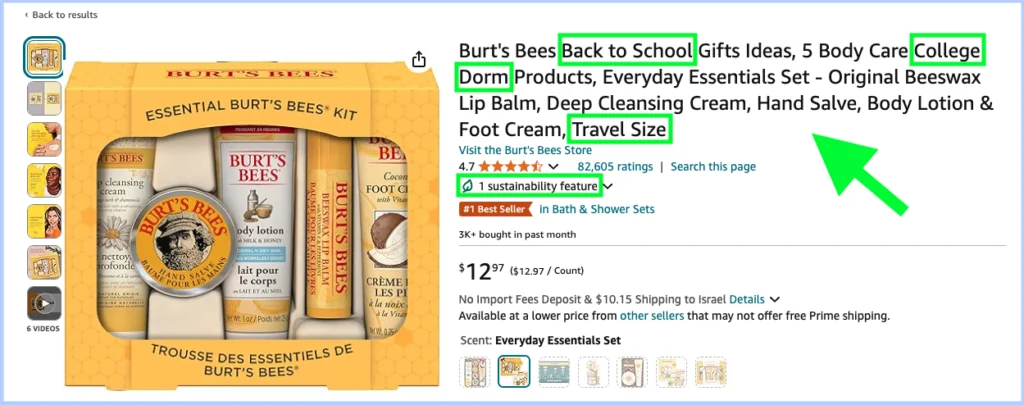
In this Amazon example, there’s a clear use of strategic keywords, it includes the brand’s name and the exact products in the kit, and there are no promotional adjectives that may hurt the original cause of the product title.
Next, the ‘About this item’ section provides a high-level overview of key benefits, features, and specifications in a scannable format. This is where bullet points shine – organizing information in this skimmable structure makes it easy for customers to digest quickly.
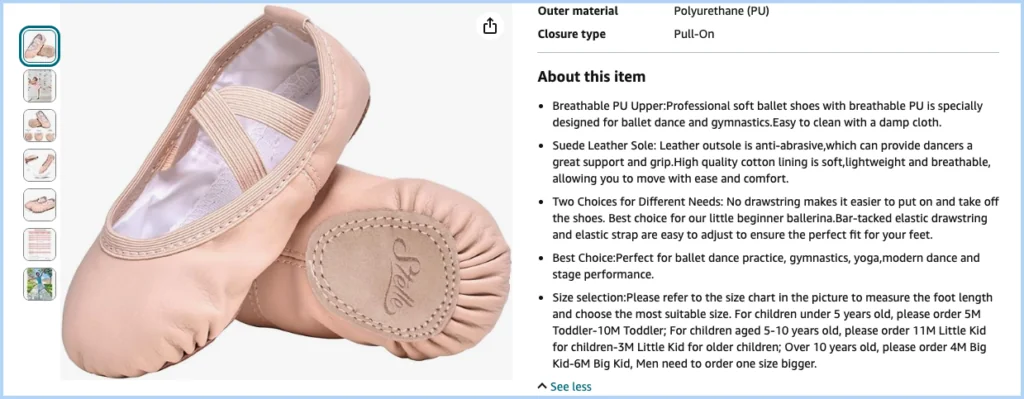
This example is a good representation of what makes a good ‘About this item’ section – it mentions and explains the key features and benefits in a digestible format. Bullet points are embedded to make the information skimmable and less unappealing than a giant ‘text wall.’
Once you’ve captured attention with your title and provided a quick overview, the product description is where you dive deeper. According to PickFu, clear and concise language is key – get to the point quickly without overwhelming potential buyers. Focus on the product’s benefits, explaining how it solves a problem or improves a customer’s life. SEO is essential here, with keywords naturally integrated to increase visibility on the platform.
A good Amazon product description balances clarity and persuasion. Amazon’s Seller Central emphasizes the importance of formatting, including bullet points to avoid overwhelming buyers with large blocks of text. Short paragraphs make it easier for customers to scan and understand key information.
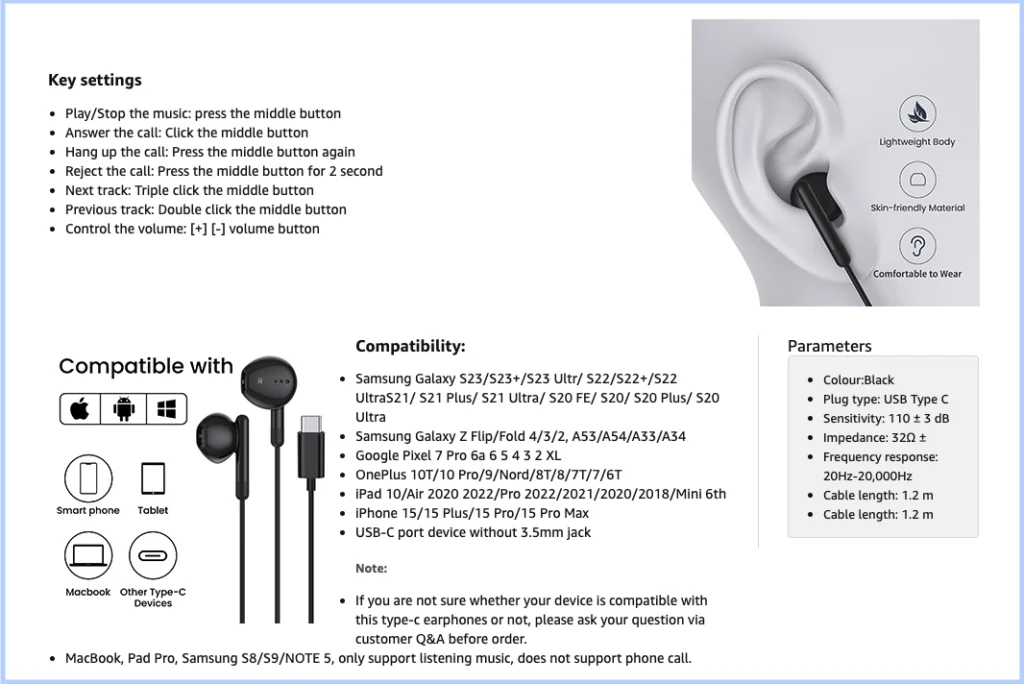
In this example from BENEWY’s ME540 USB C headphones, the seller carefully segments the text into digestible categories and incorporates visuals for readability. The visuals and text work together to create a more user-friendly experience.
In all parts of the listing, making information easily digestible – using short paragraphs, bullet points, and clear headings – is key to capturing attention and leading customers to purchase. Whether your tone is fun and quirky or technical and professional, it should align with your brand and convince the customer that your product is the right choice.
Might also interest you:
- How to write product titles and descriptions that convert
- Proven strategies to optimize Amazon product listings
- Expert tips: improve your Amazon conversion rates
How to write product listings according to Amazon’s guidelines
Amazon has strict guidelines for crafting product listings, and following them is essential for visibility and compliance.
Product titles should stay within Amazon’s character limits (200 characters) and include important keywords, while avoiding promotional terms like ‘best’ or ‘guaranteed.’ Overstuffing titles can hurt readability, so clarity is key.
In the ‘About this item’ section, bullet points should be concise yet informative, highlighting key features without exaggeration or making false claims.
Finally, the product description should adhere to Amazon’s 2,000-character limit. Better World Products suggest using all characters to maximize impact – the reason behind this is that taking up space can help you outshine your brand and listing compared to your competitors’ advertising. Amazon, on the other hand, recommends concise, accurate descriptions that avoid prohibited terms such as ‘free’ or ‘bonus.’ Misleading information can lead to negative customer experiences and even listing suspension.
According to Seller Central, using promotional language like ‘best’ or ‘guaranteed’ is also inadvisable. Accuracy is key – don’t exaggerate or make claims that can’t be backed up. Misleading descriptions can lead to poor customer experiences or even listing suspension.
Transparency and clarity are vital across all components, ensuring customers know exactly what they’re purchasing. Following Amazon’s category-specific guidelines helps protect your listings and build trust with potential buyers.
| Component | Guidelines |
|---|---|
| Product title | Stay within 200 characters and include important keywords. Avoid promotional terms like ‘best’ or ‘guaranteed.’ Clarity is key to avoid overstuffing. |
| ‘About this item’ section | Use bullet points to highlight key features. Be concise and informative without exaggerating or making false claims. |
| Product description | Adhere to the 2,000-character limit. Go for concise and accurate descriptions, and try to avoid prohibited terms like ‘free’ or ‘bonus.’ |
How to know if your product listings work (Examples)
To determine the effectiveness of your Amazon product listings, monitor key metrics such as conversion rates, click-through rates (CTR), sales, and your product’s ranking in search results. A high CTR but low conversion rate could signal that your title or ‘About this item’ section is compelling but your description fails to connect with customers.
A/B testing can help refine both titles and descriptions by testing different versions to see what resonates best with your audience. Finally, don’t underestimate the value of customer feedback – reviews and questions offer insights on where your listing may need improvement, from better descriptions to clearer product titles.

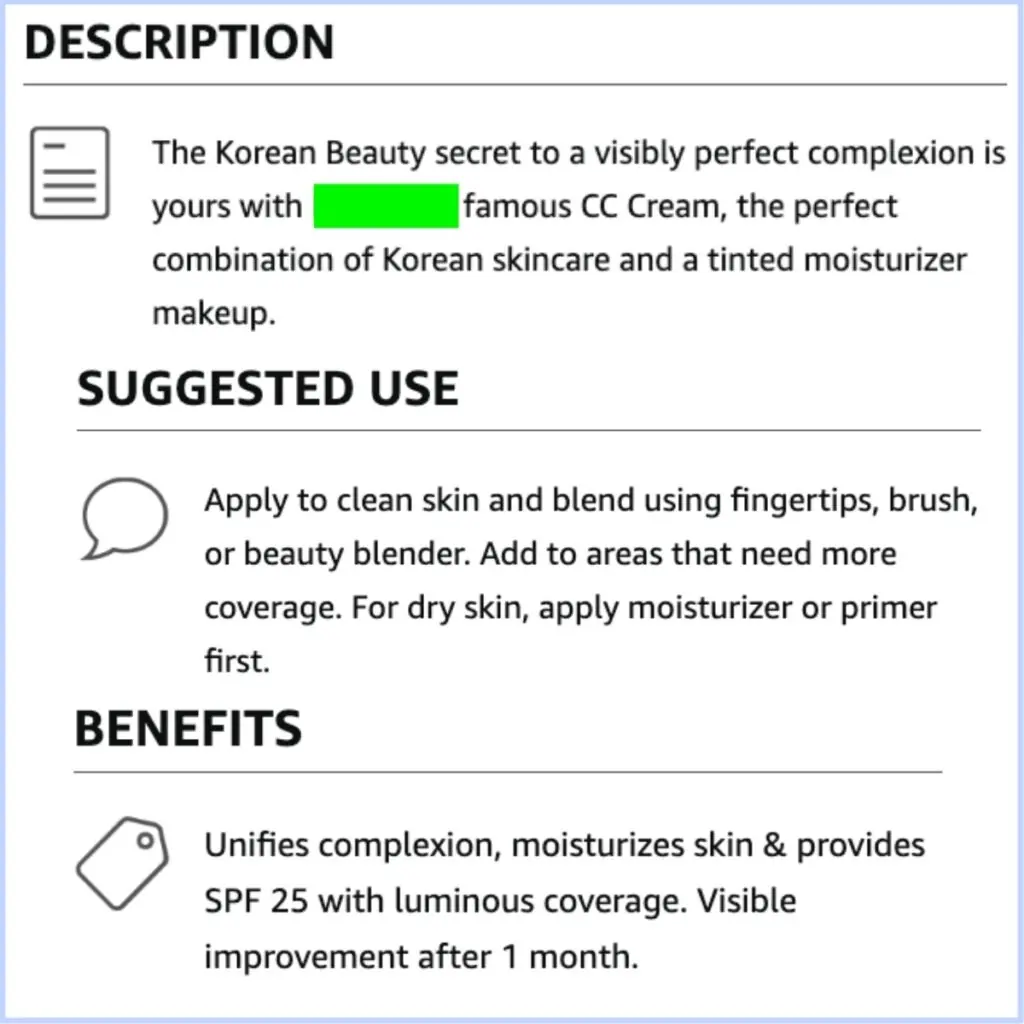
Leveraging AI tools to optimize product listings (Example)
AI tools like ChatGPT can be game-changers when optimizing all components of your Amazon product listing. Whether generating keyword-rich titles, crafting engaging ‘About this item’ sections, or producing tailored descriptions, AI helps streamline the process.
Popular content
- 14 strategies to improve your eCommerce business’s financial health
- 50+ ChatGPT prompts to elevate your eCommerce business
- A guide to pricing your product on Amazon
- 5 marketing metrics all eCommerce businesses should track
- All about Amazon PPC
AI tools are particularly valuable for SEO optimization, placing keywords naturally to boost search visibility. For sellers with large inventories, AI offers scalability by creating consistent, high-quality listings across multiple products. This saves time and ensures that each listing is optimized for conversions.
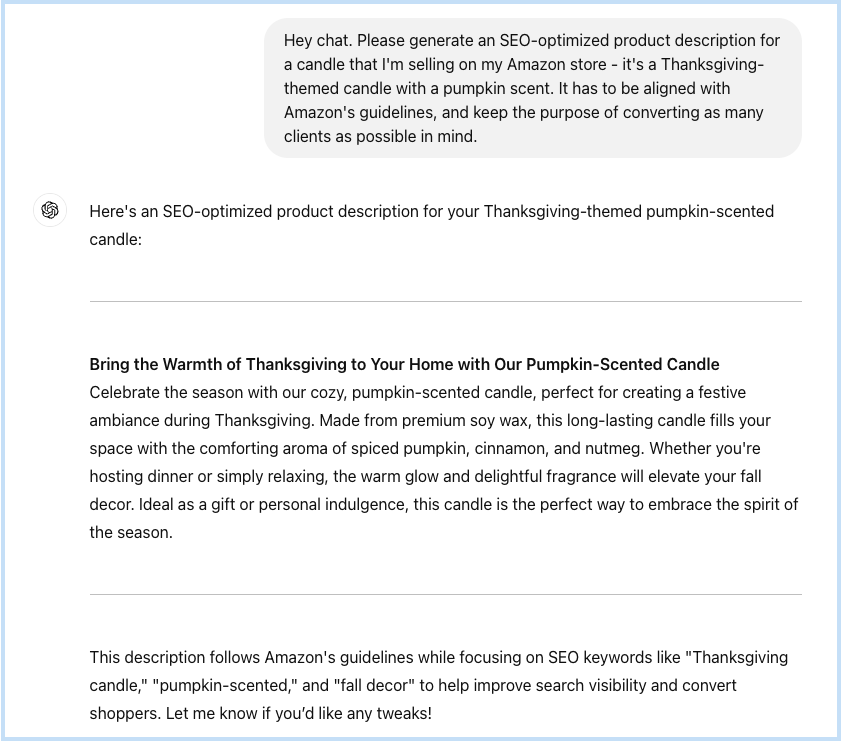
In this example, it’s easy to see just how simple and time-efficient working with AI tools like ChatGPT can be. It was able to produce a high-quality and Amazon platform-fitting description in mere seconds, which is something you should consider when writing up any component of your Amazon product listings.
Standing out in a crowded marketplace
In a marketplace as vast as Amazon, standing out requires a strategic blend of creativity and clarity. One effective method is storytelling – paint a picture of how your product solves a problem or enhances the customer’s life. Focus on specific benefits that resonate with your target audience.
Your brand voice should be distinct and consistent, giving your listing personality and setting you apart from competitors – experiment with engaging language or unexpected product features to create memorable descriptions.
Lastly, stay adaptable. Regularly updating your titles, ‘About this item’ sections, and descriptions based on customer preferences and emerging trends keeps your listings fresh and relevant.
Amazon product titles cheatsheet
Key elements –
- Primary keyword: Include the main keyword for which the product is likely to be searched.
- Brand name: Place the brand name at the beginning or end.
- Product type: Clearly describe what the product is.
- Key features: Highlight important features or benefits.
- Size / quantity: Include this if relevant to the purchase decision.
Best practices –
- Use title case: Capitalize major words in the title.
- Be concise: Aim for a title length of 150-200 characters.
- Avoid keyword stuffing: Make the title readable and natural.
Examples –
- “Instant Pot Duo 7-in-1 Electric Pressure Cooker, 6 Quart – Slow Cooker, Rice Cooker, Steamer, Saute Pan, and More”
- “Organic Green Tea Leaves – 100% Pure Loose Leaf Tea – 8 Oz – Non-GMO, Caffeine-Free, Naturally Antioxidant-Rich”
Amazon ‘About this item’ section cheatsheet
Key elements –
- Bullet points: Use bullet points for clarity and readability.
- Key features: Include the most important features and benefits.
- Unique selling points: What makes this product stand out?
- Usage instructions: Briefly mention how to use the product, if applicable.
Best practices –
- Start with the most important features: Lead with what buyers care about most.
- Be specific: Provide precise details about features and benefits.
- Include customer pain points: Address common concerns or issues the product solves.
Examples –
1. Example 1:
- 7-in-1 Functionality: Pressure cooks, slow cooks, steams, and more.
- 6-Quart Capacity: Perfect for families or meal prepping.
- Easy-to-Use Controls: Adjustable settings for customizable cooking.
- Dishwasher-Safe Parts: Hassle-free cleaning.
2. Example 2:
- 100% Organic: No artificial additives or preservatives.
- Rich in Antioxidants: Boosts health with every cup.
- Loose Leaf Tea: More flavorful than bagged tea.
- Reusable Packaging: Eco-friendly and sustainable.
Amazon product descriptions cheatsheet
Key elements –
- Engaging introduction: Hook the reader with a compelling opening.
- Detailed features: Provide a thorough explanation of features.
- Benefits: Explain how the features translate to benefits for the user.
- Usage instructions: Briefly guide the user on how to use the product.
- Call to action: Encourage the customer to make a purchase.
Best practices –
- Use persuasive language: Focus on how the product improves the customer’s life.
- Incorporate keywords: Ensure the description is SEO-friendly without keyword stuffing.
- Be concise yet informative: Provide all necessary details without overwhelming the reader.
Examples –
1. Example 1:
- Transform Your Cooking Experience: The Instant Pot Duo 7-in-1 Electric Pressure Cooker combines the functionality of seven kitchen appliances in one compact unit. Whether you’re looking to make a quick weeknight dinner or prepare a gourmet meal, this versatile cooker makes it easy with its customizable settings and large 6-quart capacity.
- Versatile and Efficient: From pressure cooking and slow cooking to steaming and sautéing, the Instant Pot Duo covers all your cooking needs. Its user-friendly interface allows you to effortlessly switch between functions, while the included recipe book offers a variety of meal ideas.
- Built for Convenience: Enjoy easy cleanup with dishwasher-safe components and spend more time savoring your meals. Plus, the keep-warm function ensures your food stays hot until you’re ready to serve.
2. Example 2:
- Experience the Purest Green Tea: Our Organic Green Tea Leaves deliver a fresh, invigorating flavor that you can only get from 100% pure, loose leaf tea. Free from additives and preservatives, this tea is perfect for those who value natural health benefits.
- Health Benefits in Every Sip: Packed with antioxidants, our green tea helps support a healthy lifestyle. Enjoy a cup any time of day to boost your energy levels and enhance your well-being.
- Eco-Friendly Choice: We prioritize sustainability with our reusable packaging, reducing environmental impact. Plus, our tea leaves are sourced from environmentally responsible farms.
Conclusion
Crafting the perfect Amazon product listing is part science, part art; it’s the fine balance of what customers want to see with what Amazon’s algorithm needs. By mastering concise, benefits-driven copy, staying compliant with platform rules, and integrating AI tools, your listings will not only capture attention – they will actually convert.
If you’re still not sure how to do it, we implore you to take inspiration from this article’s informative title – we do our best to follow these guidelines ourselves!
However, it’s important to note that product titles, ‘About this item’ sections, and descriptions are just one piece of the puzzle. As you optimize your business, 8fig is here to support your growth with flexible funding and smart financial tools that scale with you; let us help you grow your business seamlessly with personalized financial solutions.
Have article ideas, requests, or collaboration proposals? Reach out to us at editor@8fig.co – we’d love to hear from you.
- Effective budgeting techniques for small businesses
- From a small business owner to an 8-figure eCommerce expert
- 50+ ChatGPT prompts to elevate your eCommerce business
- Maximizing ROI with AI-generated content: A guide for eCommerce sellers
- Holiday rush readiness: top 8 tips for handling seasonal demand peaks
She's a former English teacher who's passionate about the written word, all while embracing the AI revolution and its countless benefits.
Subscribe to the eCommerce newsletter for
top industry insights
to our blog
Read the latest
from 8fig

AI is quietly reshaping eCommerce. Karma’s Hadas Bar-Ad explores how today’s sellers are using intelligent tools to streamline operations, boost efficiency, and drive smarter growth.

WhatsApp isn’t just for memes and group chats anymore. With a 98% open rate, it’s the secret weapon your eCommerce marketing strategy might be missing. Here’s how to do it right.

Stuck with extra inventory after Amazon’s Spring Sale? Learn five smart strategies to clear unsold stock, boost cash flow, and avoid future overstocks with smarter inventory planning.